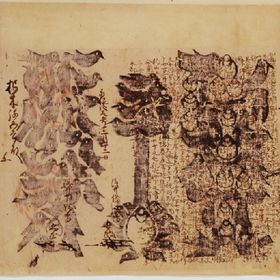- The Digital Archives Top
- Important Cultural Properties - Japanese Classics
- Kutsukike komonjo
- Asai Hisamasa and Nagamasa Rensho Kishomon
Asai Hisamasa and Nagamasa Rensho Kishomon
The Kutsuki were a branch of the Sasaki family hailing from Omi Province. They served as the stewards of the Kutsuki manor in that province in the Kamakura period, and the house continued through the Warring States period and into the Edo period, when some of their members became bannermen (direct vassals of the shogun) or daimyo (provincial lords). "The archives of Kutsuki family" consist of historical documents passed down in the family through the years. The Cabinet Records Bureau purchased them from the Kutsuki in 1888. Containing more than 1,060 documents, the archives were designated an important cultural property in the first year of Heisei( 1989).
Dated 12 December in the 11st year of Eiroku(1568), this "kishomon" (written oath) was sent by Asai Nagamasa, the lord of Odani in Omi Province, and his father Hisamasa, to Kutsuki Yagoro (Mototsuna). Such oaths consist of a preface outlining the substance and a main text stating liability to divine punishment for violation of the terms. The main text is written on the rear of an amulet slip of paper called a "goohoin." In this case, the "goohoin" is from Kumano.
This oath was prepared to strengthen the ties of alliance between the Asai and the Kutsuki. In the first year of Genki( 1570), nevertheless, Mototsuna broke the alliance and sided with Oda Nobunaga in his attack on the Asai. After the Asai were defeated by the combined Oda-Tokugawa forces in the battle at the Ane River, their castle at Odani was surrounded by Nobunaga's troops, and Hisamasa and Nagamasa committed suicide within its walls in August in the first year of Tensho(1573).
ただし、画像については「画像等データの二次利用について」をご確認ください。



